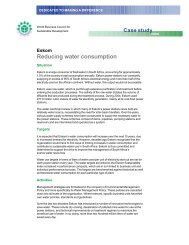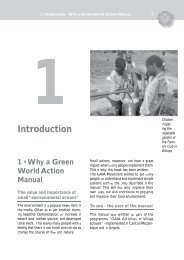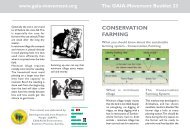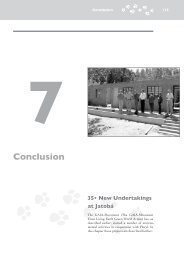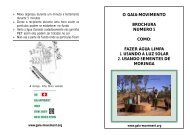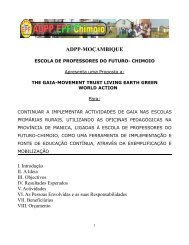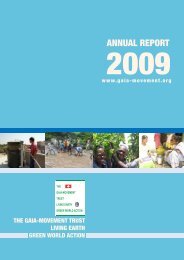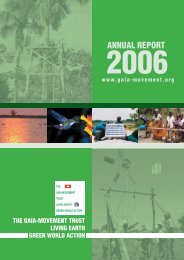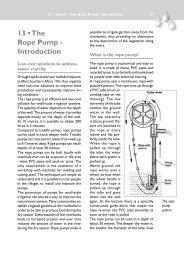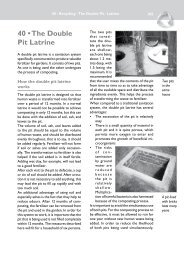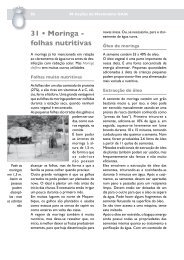Open or download the report as larger PDF file - The Gaia-Movement
Open or download the report as larger PDF file - The Gaia-Movement
Open or download the report as larger PDF file - The Gaia-Movement
Create successful ePaper yourself
Turn your PDF publications into a flip-book with our unique Google optimized e-Paper software.
Rep<strong>or</strong>t from Conference<br />
“Towards Biofuel Self-Supply -<br />
Smallholder production and local use of jatropha oil f<strong>or</strong> community<br />
development”<br />
Held on September 5, 2007, at Children’s Town, DAPP, Malambanyama,<br />
Chibombo District, Zambia.<br />
Program f<strong>or</strong> <strong>the</strong> conference:<br />
11:00 Welcome and introduction to DAPP activities in Chibombo<br />
District<br />
11:30 Tour to jatropha nursery, rope pump w<strong>or</strong>kshop,<br />
demonstration of irrigation with rope pump on a manually<br />
drilled b<strong>or</strong>ehole, demonstration of oil filtering machine,<br />
demonstration of oil press, and demonstration of Lister<br />
engine running on dual fuel system.<br />
13:00 Lunch<br />
14:00 Discussions:<br />
- problems and solutions in jatropha cultivation,<br />
- is <strong>the</strong> food versus biofuel discussion relevant?<br />
- presentation of preliminary conclusions of <strong>the</strong> dual fuel<br />
endurance tests<br />
- using plant oil <strong>or</strong> biodiesel<br />
15:00 Visit to jatropha production sites at Malambanyama School<br />
and at <strong>the</strong> farmer Michael Shichongwe.<br />
17:00 Conclusions and ending of conference.<br />
40 participants, with representatives from:<br />
- Biofuel Association of Zambia,<br />
- Bruno´s Jatropha Ltd<br />
- ILO - International Lab<strong>or</strong> Organization<br />
- D1 Oil,<br />
- Block Agricultural Extension Officer, Kembe, Chibombo District<br />
- Ministry of Community Development, Kembe Block, Chibombo<br />
- ECOSASA, South Africa,<br />
- Shakapopela Women’s Group (Hammer mill owners)<br />
- Mr. Mangwere (by representative (Hammer mill owners),<br />
- 3 o<strong>the</strong>r hammer mill owners/operat<strong>or</strong>s,<br />
- Headmen from three villages<br />
- farmers
- Agricultural Supp<strong>or</strong>t Program, Kembe Block, Chibombo District,<br />
- Conservation Farmers Union. Kembe Block, Chibombo District,<br />
- Keembe Farm Training Institute,<br />
- Malambanyama School, Mumangwa School, Children’s Town,<br />
- Staff of <strong>the</strong> DAPP Child Aid Chibombo Project<br />
- Representatives from Child Aid Mkushi, Central Province and Child<br />
Aid Mazabuka, Sou<strong>the</strong>rn Province.<br />
- <strong>The</strong> GAIA-<strong>Movement</strong><br />
Introduction to DAPP activities in Chibombo District.<br />
<strong>The</strong> project leader of DAPP Children’s Town, Annie Mulongwe,<br />
explained sh<strong>or</strong>tly about <strong>the</strong> hist<strong>or</strong>y of <strong>the</strong> Children’s Town and <strong>the</strong><br />
current activities.<br />
Ivy Choombe, Project Leader of Child Aid Chibombo, explained about<br />
<strong>the</strong> various projects in <strong>the</strong> local area. <strong>The</strong> project “Pumps f<strong>or</strong> Trees” h<strong>as</strong><br />
during <strong>the</strong> l<strong>as</strong>t year established 40 farmer groups who have received rope<br />
pumps f<strong>or</strong> small scale irrigation and started vegetable production. Each<br />
group h<strong>as</strong> produced 2,000 trees <strong>as</strong> “payment” f<strong>or</strong> <strong>the</strong> pumps.<br />
Ivy Choombe, Project Leader explaining about <strong>the</strong> Project<br />
and DAPP Child Aid activities in Chibombo District.<br />
28 Agricultural Loans Committees have been trained to manage<br />
revolving funds, and 20 loans have been established f<strong>or</strong> individual<br />
farmers and women Self Help Groups f<strong>or</strong> rope pumps. <strong>The</strong> farmers send<br />
in applications and <strong>the</strong> Committee selects <strong>the</strong> farmers who are most likely<br />
to pay back <strong>the</strong> loan f<strong>as</strong>t, so that a new loan taker can be chosen.
20 women Self Help Groups have been trained and <strong>as</strong> <strong>the</strong>y prove that<br />
<strong>the</strong>y are productive (<strong>the</strong>y have wells and are<strong>as</strong> f<strong>or</strong> gardens), <strong>the</strong>y will<br />
receive loans f<strong>or</strong> rope pumps.<br />
<strong>The</strong> “Pumps f<strong>or</strong> Trees” h<strong>as</strong> been combined with <strong>the</strong> Biofuel Project, so<br />
that many of <strong>the</strong> trees produced <strong>as</strong> repayment have been jatroph<strong>as</strong>.<br />
Finally <strong>the</strong> conference w<strong>as</strong> inf<strong>or</strong>med that 10 extra bicycles have been<br />
purch<strong>as</strong>ed, and that <strong>the</strong>se will be distributed to <strong>the</strong> Agricultural Loans<br />
Committees to <strong>as</strong>sist <strong>the</strong>m in monit<strong>or</strong>ing <strong>the</strong> production and <strong>the</strong><br />
repayment of <strong>the</strong> loan takers.<br />
<strong>The</strong> participants were <strong>the</strong>n shown <strong>the</strong> jatropha nursery at Children’s<br />
Town, where about 700 jatropha seedlings are being produced. M<strong>or</strong>ris<br />
Tembo, <strong>the</strong> Co-project Leader, explained about production from seeds<br />
and cuttings. <strong>The</strong> seedlings are produced <strong>as</strong> bare root seedlings, and it is<br />
here imp<strong>or</strong>tant not to water too much, since <strong>the</strong> root will become too<br />
deep, and <strong>the</strong> seedling will suffer when transplanted.<br />
<strong>The</strong> project is recommending to plant <strong>the</strong> seeds directly <strong>as</strong> fencing <strong>or</strong> in<br />
<strong>the</strong> field, since this will give <strong>the</strong> most drought resistant plants.<br />
Cuttings will develop plants that are less drought resistant, since <strong>the</strong> roots<br />
do not go so deep. <strong>The</strong> plants produced from cuttings also have a sh<strong>or</strong>ter<br />
life (15 years) than plants grown from seeds (50 years).<br />
Cuttings can very well be use f<strong>or</strong> fences, since it will be e<strong>as</strong>y to take new<br />
cuttings, if some of <strong>the</strong> plants die.<br />
M<strong>or</strong>ris, <strong>the</strong> Co-Project Leader, explains about jatropha<br />
production in <strong>the</strong> nursery at Children´s Town.
He also explained about some of <strong>the</strong> problems farmers had with termites<br />
and rats. After <strong>the</strong> first experiences with losing cuttings to termites, <strong>the</strong><br />
project had found out that <strong>the</strong> problem could be reduced by applying<br />
wood <strong>as</strong>h in <strong>the</strong> planting hole and around <strong>the</strong> cutting.<br />
Mr. Tyson Chisambo from Bruno´s Jatropha contributed by<br />
recommending to use <strong>the</strong> nursery area m<strong>or</strong>e intensively by reducing<br />
distances between <strong>the</strong> rows. He also explained that <strong>the</strong>y have good<br />
experiences with selling bare root jatropha seedlings.<br />
<strong>The</strong> participants were <strong>the</strong>n presented f<strong>or</strong> <strong>the</strong> rope pump at a vegetable<br />
garden at Children’s Town (CT). This pump h<strong>as</strong> been installed in a 12 m<br />
deep b<strong>or</strong>ehole, drilled with manual drilling equipment during a training<br />
w<strong>or</strong>kshop in 2006.<br />
Two kinds of rope pumps are being produced at <strong>the</strong> CT w<strong>or</strong>kshop. <strong>The</strong><br />
cheapest model is <strong>the</strong> windl<strong>as</strong>s model (pi/π model) where <strong>the</strong> handle is<br />
placed on two poles that are fixed in <strong>the</strong> ground.<br />
<strong>The</strong> A model h<strong>as</strong> a metal frame that is fixed in concrete. <strong>The</strong> models can<br />
be used with ei<strong>the</strong>r a b<strong>or</strong>ehole <strong>or</strong> a well. <strong>The</strong>y can pump up water f<strong>or</strong><br />
small scale irrigation from depth down to 2-30 meter. Treadle pumps can<br />
only go down to 6-7 m.<br />
Conference participants testing <strong>the</strong> rope pump installed on a<br />
manually drilled b<strong>or</strong>ehole of 12 m at <strong>the</strong> vegetable garden.<br />
Alex Ntambo, <strong>the</strong> water technician of <strong>the</strong> Child Aid project, explained<br />
about <strong>the</strong> manual drilling and <strong>the</strong> rope pump production, and he showed
<strong>the</strong> various parts and how <strong>the</strong> wheel and <strong>the</strong> w<strong>as</strong>hers are made from used<br />
tyres.<br />
It w<strong>as</strong> stressed that it is imp<strong>or</strong>tant to get a th<strong>or</strong>ough training to produce<br />
pumps that will w<strong>or</strong>k long time with little maintenance, and that it is<br />
imp<strong>or</strong>tant to train local village pump menders, who can install and<br />
maintain <strong>the</strong> pumps. <strong>The</strong> big advantage is that everything can be done<br />
with local materials.<br />
DAPP Zambia h<strong>as</strong> by now produced and installed over 300 rope pumps,<br />
and is/will be training staff from o<strong>the</strong>r <strong>or</strong>ganizations such <strong>as</strong> PLAN<br />
International and Water Aid.<br />
Alex Ntambo, <strong>the</strong> water technician, explaining about DAPP´s<br />
rope pump production. Over 300 pumps installed so far.<br />
A number of pumps have been given out to local Agricultural Loans<br />
Committees, who have been trained to manage revolving funds of loans<br />
f<strong>or</strong> rope pumps. <strong>The</strong>y select viable farmers, and when <strong>the</strong> loan h<strong>as</strong> been<br />
repaid - after 1-2 years due to income generated from garden production -<br />
<strong>the</strong>y can give a loan f<strong>or</strong> small-scale irrigation to a new farmer.<br />
Children’s Town h<strong>as</strong> f<strong>or</strong> a number of years pressed oil from sunflower<br />
seeds to generate income and provide a market f<strong>or</strong> local farmers. <strong>The</strong> oil<br />
press is n<strong>or</strong>mally run by an electric mot<strong>or</strong>, but <strong>the</strong> project had just<br />
purch<strong>as</strong>ed a second hand 2-cylinder Lister engine, and to be sure that <strong>the</strong><br />
engine w<strong>as</strong> strong, it had been connected to <strong>the</strong> oil press. This w<strong>as</strong> also<br />
an opp<strong>or</strong>tunity to show <strong>the</strong> participants how <strong>the</strong> dual fuel system<br />
functioned. <strong>The</strong> engine is started on diesel. When it is hot (at le<strong>as</strong>t 10<br />
minutes) fuel supply is switched to plant oil. Bef<strong>or</strong>e shutting down, <strong>the</strong>
engine is again run on diesel to clean out <strong>the</strong> filters and <strong>the</strong> inject<strong>or</strong>s.<br />
Some sunflower seeds were pressed while <strong>the</strong> engine ran on cottonseed<br />
oil.<br />
Demonstrating <strong>the</strong> pressing of oil from sunflower seeds on a<br />
press powered by <strong>the</strong> 2-cylinder Lister engine run on<br />
cottonseed oil in <strong>the</strong> dual fuel system.<br />
An oil filtering machine h<strong>as</strong> been acquired f<strong>or</strong> <strong>the</strong> project, and <strong>the</strong><br />
participants were shown how it produces clean sunflower oil from <strong>the</strong> oil<br />
pressed in <strong>the</strong> CT.<br />
Back in <strong>the</strong> meeting hall <strong>the</strong>re w<strong>as</strong> time to discuss some of <strong>the</strong> jatropha<br />
issues bef<strong>or</strong>e lunch.<br />
<strong>The</strong> participating farmers were <strong>as</strong>ked on <strong>the</strong>ir views on <strong>the</strong> food versus<br />
biofuel discussion. Would <strong>the</strong>y need to reduce <strong>the</strong>ir area f<strong>or</strong> food<br />
production to produce jatroph<strong>as</strong>. <strong>The</strong> farmers were not in doubt that this<br />
w<strong>as</strong> no problem in <strong>the</strong>ir area. <strong>The</strong>re w<strong>as</strong> ample land available, and <strong>the</strong>y<br />
could also use <strong>the</strong> land between <strong>the</strong> jatropha trees f<strong>or</strong> intercropping. One<br />
farmer explained that he had 2,000 jatropha, and w<strong>as</strong> growing maize in<br />
between <strong>the</strong> rows. He had achieved good maize yields.<br />
<strong>The</strong> Agricultural Extension Officer from Kembe Block would like to hear<br />
if <strong>the</strong>re w<strong>as</strong> anything to <strong>the</strong> rum<strong>or</strong>s that jatropha cultivation w<strong>as</strong> spoiling<br />
<strong>the</strong> soils. <strong>The</strong> representatives of <strong>the</strong> Biofuels Association of Zambia<br />
(BAZ), answered that it w<strong>as</strong> actually <strong>the</strong> farmers who could answer this.<br />
Some farmers replied that <strong>the</strong>y had not experienced any problems, but<br />
that it w<strong>as</strong> also sh<strong>or</strong>t time <strong>the</strong>y had grown jatroph<strong>as</strong>. <strong>The</strong> direct<strong>or</strong> of BAZ,
Mr. Andrew Chitembo, told how he new of many places had been<br />
growing f<strong>or</strong> many years. He had just seen a jatropha tree in Choma which<br />
must be over 50 years old, and he had never heard of any damages due to<br />
jatropha.<br />
<strong>The</strong> participants were also told how <strong>the</strong> jatropha leaves actually improve<br />
<strong>the</strong> soil under <strong>the</strong> trees.<br />
<strong>The</strong> issue of prices f<strong>or</strong> jatropha seeds w<strong>as</strong> also discussed. Prices are very<br />
high now, because <strong>the</strong>re is a demand f<strong>or</strong> seeds to start up new production.<br />
<strong>The</strong>se high prices, however, will not continue. <strong>The</strong> prices will always be<br />
linked to prices of diesel. With <strong>the</strong> current price of diesel at 5,600 Kw.<br />
(USD 1. 40) <strong>the</strong> farmers should not expect a price of m<strong>or</strong>e than 1,000<br />
Kw., since about 4 kg of seeds are needed to produce 1 l of oil.<br />
It w<strong>as</strong> also stressed that one should look at <strong>the</strong> o<strong>the</strong>r benefits, such <strong>as</strong><br />
having oil f<strong>or</strong> lamps, f<strong>or</strong> soap production and press cake which is a<br />
valuable fertilizer.<br />
A member of a Woman Self Help Group explaining her<br />
experiences with growing jatropha.<br />
After lunch, <strong>the</strong> General Manager of <strong>The</strong> GAIA-<strong>Movement</strong> made a sh<strong>or</strong>t<br />
presentation on <strong>the</strong> overall issues related to use of biofuel and <strong>the</strong> GVEP<br />
funded project.<br />
<strong>The</strong> idea of this biofuel project is to develop a system of decentralized<br />
energy generation which will benefit off-grid communities in:<br />
1. generating energy f<strong>or</strong> local development,<br />
2. generating income opp<strong>or</strong>tunities and,<br />
3. improving <strong>the</strong> local (improving tree cover) and global (reducing<br />
greenhouse g<strong>as</strong> emissions) environment.
Demonstrating how a very simple “lamp” can be made from<br />
jatropha oil and some cotton to replace candles and kerosene.<br />
Global warming w<strong>as</strong> briefly explained. <strong>The</strong> farmers agreed strongly that<br />
rainfalls had become m<strong>or</strong>e irregular and that it w<strong>as</strong> m<strong>or</strong>e difficult to<br />
predict <strong>the</strong> planting times. Africa will be <strong>the</strong> w<strong>or</strong>st affected, and<br />
especially <strong>the</strong> farmers who depend totally on rainfed agriculture. This is<br />
also why <strong>the</strong>re is a great need f<strong>or</strong> systems such <strong>as</strong> rope pumps to mitigate<br />
<strong>the</strong> effects of <strong>the</strong> unpredictable climate.<br />
To demonstrate <strong>the</strong> energy in jatropha oil, a very simple jatropha “lamp”<br />
w<strong>as</strong> used. A piece of cotton, f<strong>or</strong>med like a small pyramid, dipped in<br />
jatropha and placed on a small plate. This can e<strong>as</strong>ily replace candles <strong>or</strong><br />
kerosene lamps.<br />
This w<strong>as</strong> also used to explain <strong>the</strong> difference between using fossil fuels<br />
and biofuels.<br />
Def<strong>or</strong>estation w<strong>as</strong> brought in <strong>as</strong> a contributing fact<strong>or</strong> to global warming,<br />
which again stresses <strong>the</strong> imp<strong>or</strong>tance jatropha cultivation can have in<br />
turning this tide.<br />
<strong>The</strong> participants were <strong>the</strong>n explained about <strong>the</strong> dual fuel system, and <strong>the</strong><br />
idea of <strong>the</strong> project - to produce energy and use it locally in <strong>the</strong><br />
communities. Two hammer mills (grinding maize) had been adapted to<br />
use <strong>the</strong> dual fuel system and have run a total of 107 hours. <strong>The</strong> idea of<br />
this element w<strong>as</strong> to demonstrate in practice that plant oil is an efficient<br />
fuel. Community members were in this way able to understand that oil<br />
from jatropha seeds <strong>or</strong> cottonseed could be used <strong>as</strong> fuel in stationary<br />
engines.
It is well known that engines can run a sh<strong>or</strong>t time on plant oil with this<br />
system without problems. In <strong>or</strong>der to ensure that <strong>the</strong> hammer mills can<br />
run f<strong>or</strong> long periods, systematic endurance tests following international<br />
standards have been started at Delhi College of Engineering by Profess<strong>or</strong><br />
Naveen Kumar.<br />
<strong>The</strong> preliminary conclusions of <strong>the</strong> dual fuel endurance tests using<br />
jatropha oil in a 1-cylinder Kirloskar engine were presented. After<br />
running 216 hours on jatropha, <strong>the</strong>re were some deposits on <strong>the</strong> filters<br />
and <strong>the</strong> inject<strong>or</strong>s, and some of <strong>the</strong> compression rings were sticking. <strong>The</strong>y<br />
have now been changed and <strong>the</strong> engine is tested up to <strong>the</strong> standard 512<br />
hours. Profess<strong>or</strong> Kumar is optimistic that a viable system can be<br />
developed and recommends that new tests are made, where <strong>the</strong> oil is<br />
heated by being coiled around a hot engine part bef<strong>or</strong>e being injected.<br />
<strong>The</strong> GAIA-<strong>Movement</strong> will secure funding f<strong>or</strong> continued tests, until a<br />
viable and safe dual fuel system h<strong>as</strong> been developed.<br />
<strong>The</strong> representatives from BAZ received a copy of <strong>the</strong> preliminary<br />
findings from Delhi and <strong>the</strong> participants with access to computers were<br />
promised that a copy of <strong>the</strong> presentation would be sent to <strong>the</strong>m by email<br />
<strong>or</strong> on a CD-Rom.<br />
Visit to <strong>the</strong> jatroph<strong>as</strong> at Malambanyama School. <strong>The</strong> teacher<br />
and Ms. Mpala from ILO looking at <strong>the</strong> healthy plants.<br />
<strong>The</strong> participants <strong>the</strong>n drove to visit <strong>the</strong> jatropha production at<br />
Malambanyama School. <strong>The</strong> teachers of <strong>the</strong> school had <strong>or</strong>ganized <strong>the</strong><br />
students to plant about 300 jatroph<strong>as</strong> in November 2006. <strong>The</strong> trees looked<br />
healthy. In a part of <strong>the</strong> garden vegetables were grown in beds toge<strong>the</strong>r
<strong>the</strong> jatropha trees. <strong>The</strong>se had been watered regularly, while <strong>the</strong> o<strong>the</strong>r half<br />
had received less water. <strong>The</strong> teacher w<strong>as</strong> <strong>as</strong>ked if <strong>the</strong>y had experienced<br />
any problems with insects. <strong>The</strong>re had been some, but not very much. <strong>The</strong><br />
jatroph<strong>as</strong> had been sprayed when <strong>the</strong> vegetables were sprayed. Mr.<br />
Chisambo of BAZ explained that an efficient spray could be made by<br />
using wood <strong>as</strong>h, soap, kerosene. Chili <strong>or</strong> hot pepper could also be used.<br />
Christian Fenger told about Tephrosia, and how an efficient biopesticide<br />
could be made from <strong>the</strong> leaves.<br />
Next visit w<strong>as</strong> at <strong>the</strong> farmer Michael Shichongwe in Lonjofwa. He did<br />
not know how many jatroph<strong>as</strong> he had, but it could be close to 1,000.<br />
Some had been planted in <strong>the</strong> first half of 2006, and many of <strong>the</strong>se were<br />
nearly 2 m tall. He had received <strong>the</strong>se seeds <strong>as</strong> a “p<strong>as</strong>s-on” loan from<br />
ano<strong>the</strong>r DAPP project. <strong>The</strong> jatroph<strong>as</strong> had experienced cold spells <strong>the</strong> first<br />
year, which had resulted in many branches, and thus <strong>the</strong> possibility to<br />
produce many m<strong>or</strong>e fruits.<br />
He had already harvested a few kg of seeds, which he had sold f<strong>or</strong> 5,000<br />
Kw per kg (USD 1.25).<br />
Mr. Shichongwe explained that <strong>the</strong> land had not been used f<strong>or</strong> some time<br />
bef<strong>or</strong>e <strong>the</strong> jatroph<strong>as</strong> were planted.<br />
It w<strong>as</strong> <strong>as</strong>ked when it would be best to prune <strong>the</strong> jatroph<strong>as</strong> and make<br />
cuttings to incre<strong>as</strong>e <strong>the</strong> production. Mr. Chisambo explained that one<br />
should count 9 nodes f<strong>or</strong> each cutting. <strong>The</strong> first pruning should not take<br />
place until <strong>the</strong> plant is about 1.5 m high. Mr. Shichongwe w<strong>as</strong> happy to<br />
learn that he could start to make cuttings, since he did not know this.<br />
Mr. Chisambo from Biofuels Association of Zambia<br />
explaining to Mr. Shichongwe how to produce cuttings.
Back in <strong>the</strong> Children’s Town, final comments were made. Ms. Mpala<br />
from ILO (International Lab<strong>or</strong> Organization) explained that <strong>the</strong>y were<br />
w<strong>or</strong>king with <strong>the</strong> biofuel issue <strong>as</strong> a way to promote employment. She w<strong>as</strong><br />
happy to have learned about <strong>the</strong> project and stressed that it w<strong>as</strong> very<br />
imp<strong>or</strong>tant <strong>the</strong> progress and results were documented. She would also<br />
recommend to media people to visit <strong>the</strong> project.<br />
Ms. Annie Sugrue from ECOSASA (South Africa) said it had been a very<br />
good experience f<strong>or</strong> her, and that she could use this in her endeav<strong>or</strong> to get<br />
South Africa to approve jatropha cultivation <strong>as</strong> a way to create<br />
development f<strong>or</strong> smallholder farmers.<br />
Mrs. Chitembo w<strong>as</strong> happily surprised to learn that many women were<br />
already involved in jatropha cultivation. She is planning to start up<br />
production and had not expected o<strong>the</strong>r women to be interested in<br />
producing jatropha.<br />
Christian Fenger explained that <strong>the</strong> GAIA-<strong>Movement</strong> would continue to<br />
seek funding and supp<strong>or</strong>t <strong>the</strong> biofuel activities in <strong>the</strong> project area, and that<br />
<strong>the</strong>y w<strong>as</strong> currently a good chance of getting funding to expand <strong>the</strong><br />
activities in Chibombo District and start similar activities in Mkushi<br />
District. He also briefly explained about <strong>the</strong> carbon trading system, and<br />
that <strong>the</strong>y were hoping soon to be able to obtain additional funds to<br />
supp<strong>or</strong>t community biofuel and treeplanting activities.<br />
Mr. Chisambo and Mr. Chitembo from BAZ gave some facts on <strong>the</strong><br />
perspectives of biofuel production in Zambia. <strong>The</strong> country h<strong>as</strong> 75 million<br />
ha land of which 42 million ha are arable. 38 million ha of <strong>the</strong>se are not<br />
used. Only 1 million ha is needed to produce <strong>the</strong> biofuels necessary to<br />
replace Zambia’s imp<strong>or</strong>t of petrol (450,000 l/day), diesel (1,500,000<br />
l/day) and kerosene (50,000 l/day).<br />
<strong>The</strong>y also inf<strong>or</strong>med that two groups were setting up biodiesel production<br />
units within <strong>the</strong> next months. Amanita will produce 15,000 l/day and<br />
Oval Biofuel would install a pilot plant to produce 3,000 l/day.<br />
Marli investment would also soon install a production unit.<br />
<strong>The</strong> farmers were told that <strong>the</strong>re would be no problem selling <strong>the</strong> jatropha<br />
seeds. It w<strong>as</strong> also recommended that <strong>the</strong>y use <strong>as</strong> much of <strong>the</strong> oil <strong>as</strong><br />
possible locally, since this will give <strong>the</strong> best economy.<br />
With <strong>the</strong>se remarks and comments <strong>the</strong> conference w<strong>as</strong> terminated, and all<br />
participants left with <strong>the</strong> streng<strong>the</strong>ned view that local biofuel production<br />
will influence and contribute to local development in Zambia.



